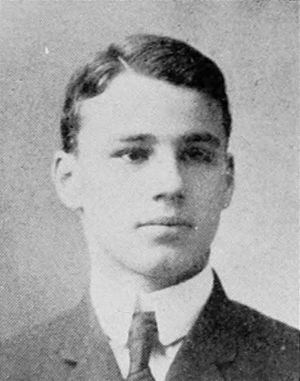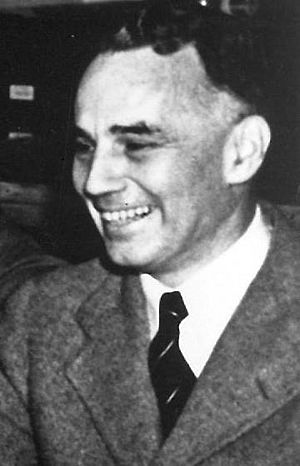Alfred Lee Loomis facts for kids
Alfred Lee Loomis (born November 4, 1887 – died August 11, 1975) was an amazing American who was many things: a lawyer, an investment banker, a philanthropist (someone who gives money to good causes), a scientist, and a physicist. He was also an inventor, creating the LORAN Long Range Navigation System. He loved supporting scientific research throughout his life.
Loomis built his own special science lab called the Loomis Laboratory in Tuxedo Park, New York. His important work helped develop radar and the atomic bomb. These inventions were very important for the Allied victory in World War II. He also invented the Aberdeen Chronograph to measure how fast artillery shells moved. He played a big part in creating a system called ground-controlled approach for airplanes, which helps them land safely. He was even involved in the early meetings for the Manhattan Project, which developed the atomic bomb.
Loomis also helped create new tools for studying biology. He worked with Edmund Newton Harvey to invent the microscope centrifuge. This device spins tiny samples very fast so scientists can study them better. He also helped pioneer techniques for electroencephalography, which measures brain waves. In 1937, he discovered a special brainwave during sleep called the K-complex. During the Great Depression, a tough time for many, Loomis secretly paid fees for scientists to publish their work in the Physical Review journal if they couldn't afford it.
Contents
Early Life and Family

Alfred Loomis was born in Manhattan. His family was well-known, especially as doctors. His parents separated when he was young, and his father passed away when Alfred was in college. His first cousin, Henry Stimson, was a very important person in the government, working for several presidents. Henry Stimson had a big influence on young Alfred.
Alfred went to Phillips Academy and then studied math and science at Yale University. He later graduated with honors from Harvard Law School in 1912. Right after law school, Loomis got married and started working as a corporate lawyer. He was very good at it.
His first wife was Ellen Holman Farnsworth. They married on June 22, 1912, and had three sons: Alfred Lee Jr., William Farnsworth, and Henry.
In 1917, Alfred Loomis and his brother-in-law, Landon K. Thorne, bought a huge piece of land (about 17,000 acres or 69 square kilometers) on Hilton Head Island, South Carolina. They turned it into a private area for riding, boating, fishing, and hunting. Loomis loved cars and yachting, even racing his yachts against famous families like the Vanderbilts and Astors.
Military Service and Finance Career
When the United States joined World War I in 1917, Loomis volunteered for the military. He became a captain and later a lieutenant colonel. He worked on ballistics (the study of how projectiles move) at the Aberdeen Proving Ground in Maryland. There, he invented the Aberdeen Chronograph. This was the first tool that could accurately measure how fast artillery shells left the gun, and it was small enough to use on the battlefield. At Aberdeen, he met physicist Robert W. Wood, who inspired Loomis to become serious about experimental physics.
In the 1920s, instead of going back to law, Loomis worked with his brother-in-law, Landon K. Thorne. They bought a company called Bonbright and Company. They helped it grow from almost failing to become a top investment banking firm. They focused on financing electric companies as electricity spread across rural America. Loomis became very wealthy and served on the boards of many banks and electric companies. They helped create the idea of a holding company, which brought many electric companies together on the East Coast of the United States.
In 1928, Loomis and his partners realized that the stock market was going to crash. They changed their investments into gold before the Wall Street Crash of 1929 happened. When the market crashed and many people lost everything, Loomis and his firm became even wealthier. They bought stocks cheaply after prices dropped, while most people didn't have the money to invest. Later, Loomis worked closely with President Franklin D. Roosevelt to prepare the country's technology for war. He used his many connections in finance and even his own money to fund early radar developments before the government could provide funds.
The Tuxedo Park Laboratory
Alfred Loomis used his great wealth to follow his passion for science. He built a private laboratory near his home in Tuxedo Park, New York. He and his small team did important early research in many areas. They studied spectrometry (how light interacts with matter), high-frequency sound, and tiny waves on water. They also worked on electro-encephalography (measuring brain waves) and very precise timekeeping.
Eventually, Loomis was elected to the National Academy of Sciences for his physics work. His lab was one of the best, with equipment that many universities couldn't afford. His reputation grew, especially in Europe, where money for science was scarce. Loomis often paid for famous European scientists to travel to his lab in the United States. They would be picked up in his limousine. At first, some scientists called him an "eccentric dabbler." But soon, his lab became a meeting place for some of the greatest scientists of the time, like Albert Einstein, Werner Heisenberg, Niels Bohr, James Franck, and Enrico Fermi. Those who worked with him knew he was very capable and hardworking. His wealth, connections, and charm made him very influential.
His Tuxedo Park lab was nicknamed "The Palace of Science." It truly became a hub for the most visionary minds of the 20th century. In 1934, he received the Franklin Institute's John Price Wetherill Medal for his work.
In 1939, Loomis started working with Ernest Lawrence. He was key in helping to fund Lawrence's project to build a huge 184-inch (4.7-meter) cyclotron (a type of particle accelerator). By this time, Loomis was a leading figure in experimental physics. He moved his Tuxedo Park operations to Cambridge, Massachusetts, and started a joint project with the Massachusetts Institute of Technology (MIT).
World War II Contributions

In the late 1930s, Loomis's science team started focusing on radio detection. They built a simple microwave radar system and put it in the back of a van. They used it to track cars on a highway and then small airplanes at an airport.
Loomis had visited the United Kingdom and knew many British scientists working on radar. Britain was at war with Germany and being bombed nightly. American scientists were trying to stay out of the war. British scientists had developed a key part for radar called the cavity magnetron. This made their radar small enough to fit in airplanes. In 1940, a British group called the Tizard Mission came to the United States to ask for help making this technology in large amounts.
When Loomis heard that the British magnetron was much more powerful than anything in America, he invited its inventors to Tuxedo Park. Because he had done more work in this area than anyone else, Loomis was chosen to lead the Microwave Committee for the National Defense Research Committee. Within a month, he found a building at MIT to set up a lab. He called it the MIT Radiation Laboratory, or Rad Lab. He pushed hard for radar development, even when the Army was unsure. He also arranged funding for the Rad Lab until the government could provide money.
The MIT Rad Lab was led by Lee DuBridge. Loomis's job was to remove any problems that slowed down research and to encourage the scientists. The radar they developed, which used 10-cm waves, was a key technology. It helped sink German U-boats, warned the British about incoming German bombers, and provided cover for the D-Day landing. Loomis used all his business skills and contacts to make sure development happened quickly. DuBridge later said, "Radar won the war; the atom bomb ended it."
Loomis also proposed the LORAN system, originally called "LRN" for Loomis Radio Navigation. It became the most widely used long-range navigation system before GPS. The Rad Lab developed this system, which uses pulsed radio signals. A worldwide network of LORAN stations once existed, though many stopped broadcasting in 2010.
Loomis also made a big contribution to ground-controlled approach technology. This system uses radar to help air traffic controllers guide pilots to land safely, even when they can't see well due to fog or bad weather. It was a very important step towards today's instrument landing systems.
Legacy and Later Years
President Roosevelt praised Loomis's work, saying he was perhaps the most important civilian, after Churchill, in helping the Allies win World War II.
Loomis was recognized by many important groups. He was elected to the American Philosophical Society in 1930 and the National Academy of Sciences in 1940. He also received several honorary degrees from universities like Wesleyan University, Yale University, and the University of California.
Alfred Loomis was married to Ellen Farnsworth for over 30 years. She faced health challenges. They had three children: Alfred Jr., who was a successful investor and sailor; Henry, who led the Corporation for Public Broadcasting; and Farnsworth, a doctor and professor. (Farnsworth's grandson is Reed Hastings, who co-founded Netflix.)
After his wife's health declined, Loomis changed his lifestyle. He gave up his many homes and servants and settled into a simpler life with his wife. They remained married until Alfred Loomis passed away more than 30 years later.
Alfred Loomis was a very private person who avoided public attention. After the Rad Lab closed and his war duties ended in 1947, he completely retired from public life. He moved to East Hampton and never gave another interview.
Patents
- External shoe tree, 1914 U.S. Patent 1,106,465
- Net, 1916 U.S. Patent 1,184,466
- Toy, 1917 U.S. Patent 1,222,005
- Chronograph, 1921 U.S. Patent 1,376,890
- Method and apparatus for forming emulsions and the like, 1929 U.S. Patent 1,734,975
- Microscope centrifuge, 1933 U.S. Patent 1,907,803


